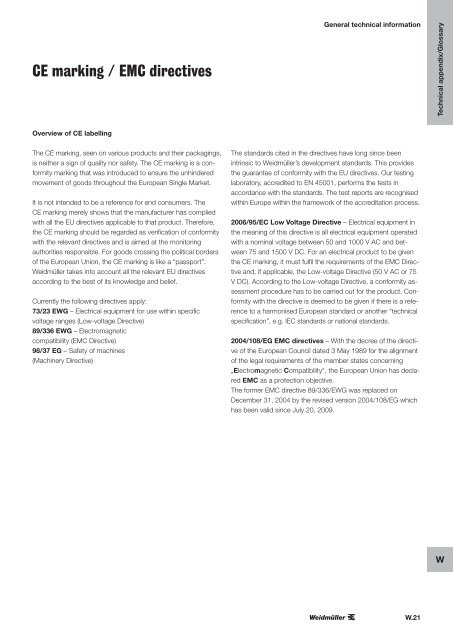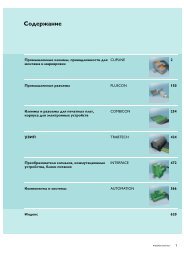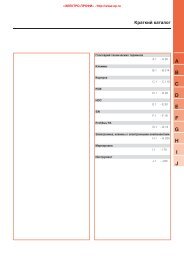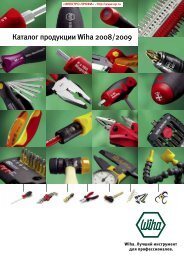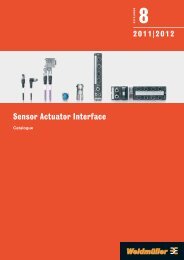ÐаÑалог Weidmuller: Electronics - Analogue Signal Conditioning
ÐаÑалог Weidmuller: Electronics - Analogue Signal Conditioning
ÐаÑалог Weidmuller: Electronics - Analogue Signal Conditioning
Create successful ePaper yourself
Turn your PDF publications into a flip-book with our unique Google optimized e-Paper software.
CE marking / EMC directives<br />
General technical information<br />
Technical appendix/Glossary<br />
Overview of CE labelling<br />
The CE marking, seen on various products and their packagings,<br />
is neither a sign of quality nor safety. The CE marking is a conformity<br />
marking that was introduced to ensure the unhindered<br />
movement of goods throughout the European Single Market.<br />
It is not intended to be a reference for end consumers. The<br />
CE marking merely shows that the manufacturer has complied<br />
with all the EU directives applicable to that product. Therefore,<br />
the CE marking should be regarded as verification of conformity<br />
with the relevant directives and is aimed at the monitoring<br />
authorities responsible. For goods crossing the political borders<br />
of the European Union, the CE marking is like a “passport”.<br />
Weidmüller takes into account all the relevant EU directives<br />
according to the best of its knowledge and belief.<br />
Currently the following directives apply:<br />
73/23 EWG – Electrical equipment for use within specific<br />
voltage ranges (Low-voltage Directive)<br />
89/336 EWG – Electromagnetic<br />
compatibility (EMC Directive)<br />
98/37 EG – Safety of machines<br />
(Machinery Directive)<br />
The standards cited in the directives have long since been<br />
intrinsic to Weidmüller’s development standards. This provides<br />
the guarantee of conformity with the EU directives. Our testing<br />
laboratory, accredited to EN 45001, performs the tests in<br />
accordance with the standards. The test reports are recognised<br />
within Europe within the framework of the accreditation process.<br />
2006/95/EC Low Voltage Directive – Electrical equipment in<br />
the meaning of this directive is all electrical equipment operated<br />
with a nominal voltage between 50 and 1000 V AC and between<br />
75 and 1500 V DC. For an electrical product to be given<br />
the CE marking, it must fulfil the requirements of the EMC Directive<br />
and, if applicable, the Low-voltage Directive (50 V AC or 75<br />
V DC). According to the Low-voltage Directive, a conformity assessment<br />
procedure has to be carried out for the product. Conformity<br />
with the directive is deemed to be given if there is a reference<br />
to a harmonised European standard or another “technical<br />
specification”, e.g. IEC standards or national standards.<br />
2004/108/EG EMC directives – With the decree of the directive<br />
of the European Council dated 3 May 1989 for the alignment<br />
of the legal requirements of the member states concerning<br />
„Electromagnetic Compatibility“, the European Union has declared<br />
EMC as a protection objective.<br />
The former EMC directive 89/336/EWG was replaced on<br />
December 31, 2004 by the revised version 2004/108/EG which<br />
has been valid since July 20, 2009.<br />
W<br />
W.21


